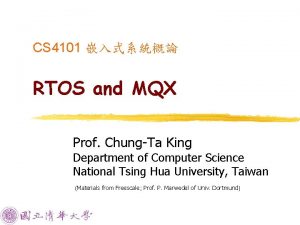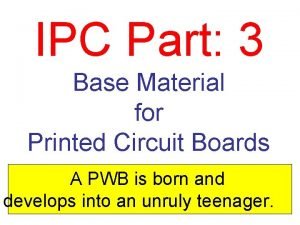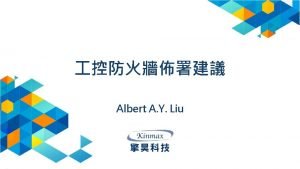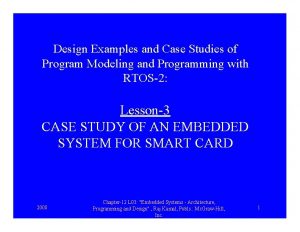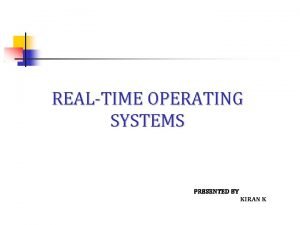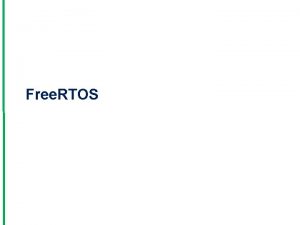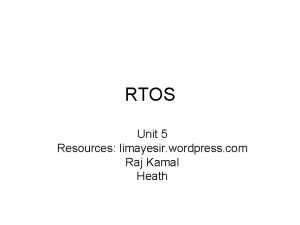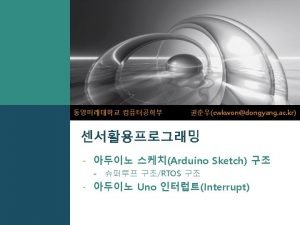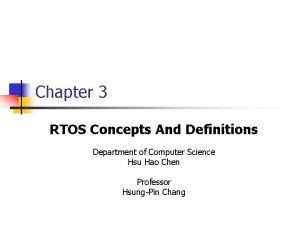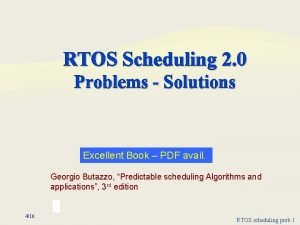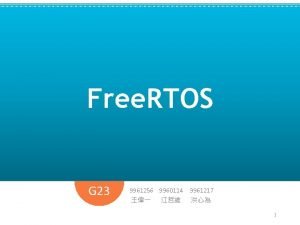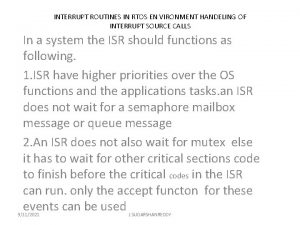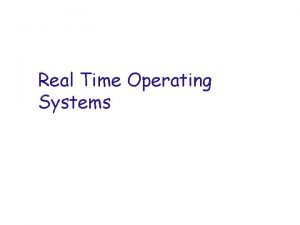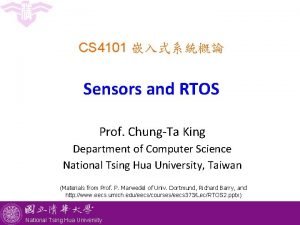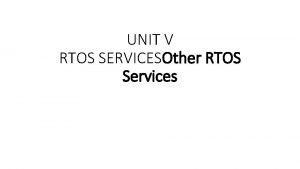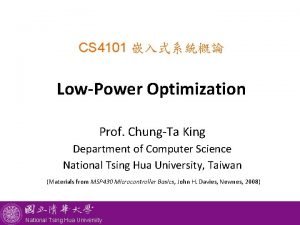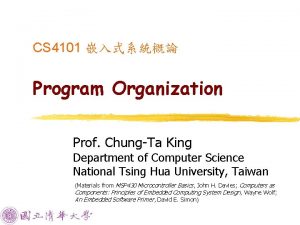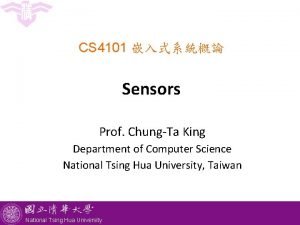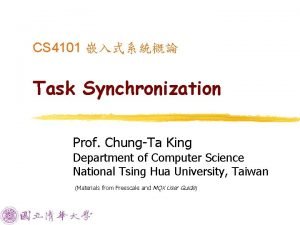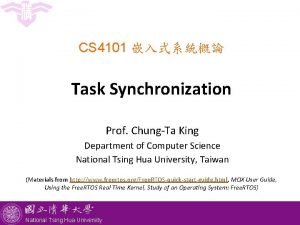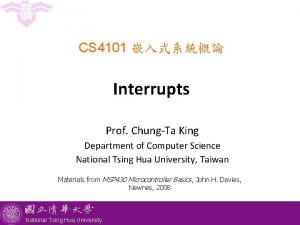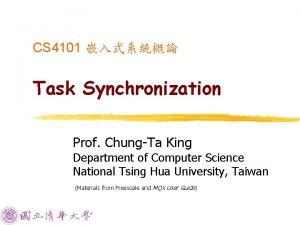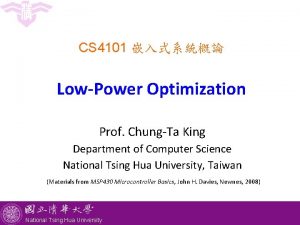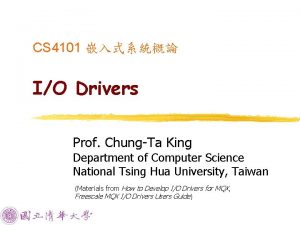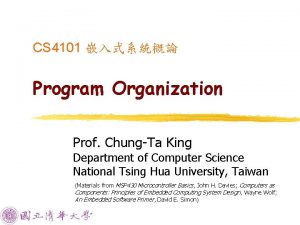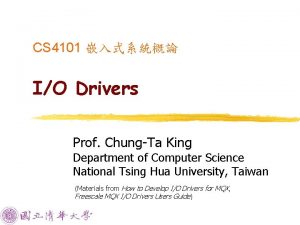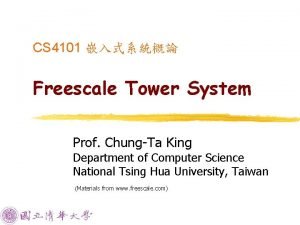CS 4101 RTOS Prof ChungTa King Department of
















- Slides: 16

CS 4101 嵌入式系統概論 RTOS Prof. Chung-Ta King Department of Computer Science National Tsing Hua University, Taiwan (Materials from Freescale; Prof. P. Marwedel of Univ. Dortmund)

Operating Systems t The collection of software that manages a system’s hardware resources l Often include a file system module, a GUI and other components Often times, a “kernel” is understood to be a subset of such a collection t Characteristics t l Resource management l Interface between application and hardware l Library of functions for the application 1

Embedded Operating Systems t t Fusion of the application and the OS to one unit Characteristics: l Resource management n Primary internal resources l Less overhead l Code of the OS and the application mostly reside in ROM 2

Desktop vs Embedded OS t Desktop: applications are compiled separately from the OS t Embedded: application is compiled and linked together with the embedded OS l On system start, application usually gets executed first, and it then starts the RTOS. l Typically only part of RTOS (services, routines, or functions) needed to support the embedded application system are configured and linked in (Dr Jimmy To, EIE, POLYU) 3

Characteristics of Embedded OS t Configurability: l No single OS fit all needs, no overhead for unused functions configurability t Techniques for implementing configurability l Simplest form: remove unused functions (by linker ? ) l Conditional compilation (using #if and #ifdef commands) l Advanced compile-time evaluation and optimization l Object-orientation specialized to a derived subclasses 4

Characteristics of Embedded OS t Device drivers often not integrated into kernel l Embedded systems often application-specific devices move device out of OS to tasks l For desktop OS, many devices are implicitly assumed to be presented, e. g. , disk, network, audio, etc. they need to be integrated to low-level SW stack Embedded OS Standard OS kernel 5

Characteristics of Embedded OS t Protection is often optional l Embedded systems are typically designed for a single purpose, untested programs rarely loaded, and thus software is considered reliable l Privileged I/O instructions not necessary and tasks can do their own I/O Example: Let switch be the address of some switch Simply use load register, switch instead of OS call 6

Characteristics of Embedded OS t Interrupts not restricted to OS l Embedded programs can be considered to be tested l Protection is not necessary l Efficient control over a variety of devices is required can let interrupts directly start or stop tasks (by storing task’s start address in the interrupt table) more efficient than going through OS services l But for standard OS: serious source of unreliability l Reduced composability: if a task is connected to an interrupt, it may be difficult to add another task which also needs to be started by an event. 7

Characteristics of Embedded OS t Real-time capability l Many embedded systems are real-time (RT) systems and, hence, the OS used in these systems must be real-time operating systems (RTOSs) t Features of a RTOS: l Allows multi-tasking l Scheduling of the tasks with priorities l Synchronization of the resource access l Inter-task communication l Time predictable l Interrupt handling 8

Outline t Introduction to embedded operating systems l Comparison with desktop operating systems l Characteristics of embedded operating systems t Introduction to real-time operating systems l Requirements for an OS to be a real-time OS l Classification of RTOS t Introduction to MQX and sample code 9

Requirements for RTOS t Predictability of timing l The timing behavior of the OS must be predictable l For all services of the OS, there is an upper bound on the execution time l Scheduling policy must be deterministic l The period during which interrupts are disabled must be short (to avoid unpredictable delays in the processing of critical events) 10

Requirements for RTOS t OS should manage timing and scheduling l OS possibly has to be aware of task deadlines; (unless scheduling is done off-line). l Frequently, the OS should provide precise time services with high resolution. n Important if internal processing of the embedded system is linked to an absolute time in the physical environment t Speed: l The OS must be fast 11

Functionality of RTOS Kernel t t t Processor management Memory management resource management Timer management Task management (resume, wait etc) Inter-task communication and synchronization 12

Why Use an RTOS? t t t t Can use drivers that are available with an RTOS Can focus on developing application code, not on creating or maintaining a scheduling system Multi-thread support with synchronization Portability of application code to other CPUs Resource handling by RTOS Add new features without affecting higher priority functions Support for upper layer protocols such as: l TCP/IP, USB, Flash Systems, Web Servers, l CAN protocols, Embedded GUI, SSL, SNMP 13

Classification of RTOS t RT kernels vs modified kernels of standard OS l Fast proprietary kernels: may be inadequate for complex systems, because they are designed to be fast rather than to be predictable in every respect, e. g. , QNX, PDOS, VCOS, VTRX 32, Vx. WORKS l RT extensions to standard OS: RT-kernel runs all RTtasks and standard-OS executed as one task on it t t General RTOS vs RTOS for specific domains Standard APIs vs proprietary APIs l e. g. POSIX RT-Extension of Unix, ITRON, OSEK) Source: R. Gupta, UCSD 14

Ex. : RT-Linux Init Bash Mozilla t scheduler Linux-Kernel driver RT-tasks cannot use standard OS calls (www. fsmlabs. com) RT-Task interrupts I/O RT-Linux RT-Scheduler interrupts Hardware 15

